Cleaning up our gardens too soon and removing all the plant debris and leaves can have a detrimental effect on beneficial insect populations over winter. When habitat and food for beneficial insects are not supplied in our gardens and landscapes, pest populations such as aphids, mealybugs, whiteflies and psyllids can get out of control. By leaving fallen leaves in the perennial garden and perennial plant growth from a given growing season in place for the winter, we provide shelter and insulation for the eggs, larvae, pupae and adults of overwintering beneficial insects (and pollinators), including lacewings.
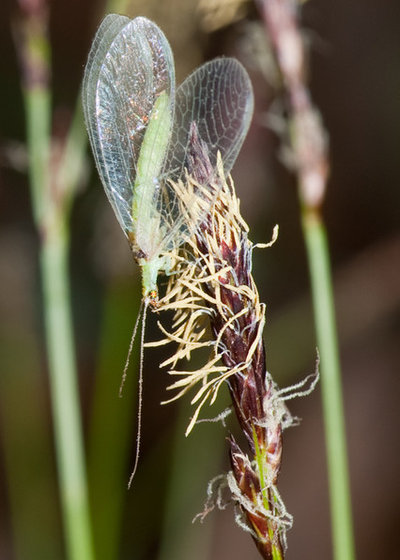
Holm Design & Consulting LLC
Latin name: Order Neuroptera;
families Chrysopidae and Hemerobiidae
Common names: Green lacewings, brown lacewings; larvae (babies) are often referred to as aphid lions
Common genera: Chrysopidae family (green lacewings):
Eupeodes, Ceraeochrysa, Chrysopa and
Chrysoperla spp;
Hemerobiidae family (brown lacewings):
Hemerobius, Megalomus, Micromus, Sympherobius and
Wesmaelius spp
Distribution: Lacewings are abundant, diverse and found throughout most of the world
Habitat: In or near woodlands, in gardens and old fields
Lacewing eggs and cocoons are attached to leaves and plant stems in fall and winter — a population of beneficial insects awaiting to emerge. Think of the perennial debris as a natural mulch. The debris will help suppress weed growth and help keep the soil moist, and the lacewings will reward you with the next generation of larvae, voracious predators of aphids, whiteflies, mealybugs and all the other problematic insects in your garden.
By altering your current garden management practices, reducing or eliminating your pesticide use, and ensuring that you have a diversity of plants that flower throughout the growing season, you will be rewarded with a healthy population of lacewings.
Shown: Green lacewing adult feeding on pollen on sprengel’s sedge (
Carex spregelli)
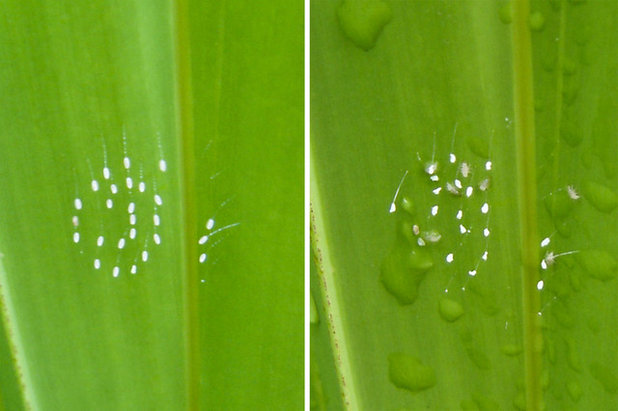
Loret Setters
When to look for them: Lacewings have multiple generations per year; they are active as adults from early spring until late fall; green lacewing adults are especially common in early spring. Adults visit flowers to feed on pollen, nectar and aphid honeydew.
Eggs and larvae can be found on the underside of leaves, where their prey occurs, from late spring until late summer. Green lacewing eggs are white to light cream in color and suspended from a leaf by a silk-like thread. Brown lacewing eggs are attached directly to a leaf, either singly or in clusters, and range from white to pinkish cream in color.
Shown: Green lacewing eggs (left) and green lacewing larvae just hatched (right)
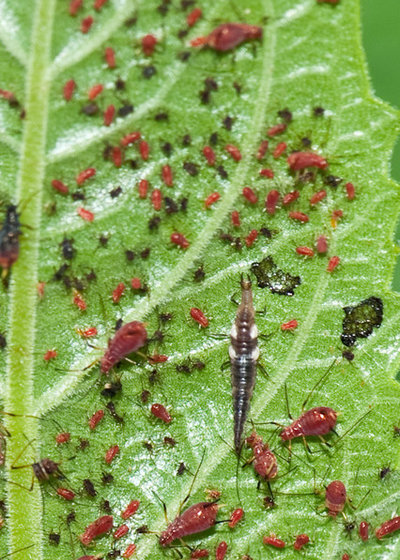
Holm Design & Consulting LLC
How They HelpLacewing larvae are voracious predators, feeding on hundreds of aphids each per week. If you have an aphid problem, it won’t take long for lacewing larvae to devour the insect population. Other prey includes psyllids, mealybugs and thrips.
Gardening for lacewings is quite simple if you follow these four recommendations:
1. Plant a variety of open flower forms with resources that are easy to access. Adult lacewings feed on nectar, pollen and honeydew.
2. Ensure that you have plants that will flower throughout the season, from early spring until fall. Plants provide food for adults and support the beneficial insects that will prey on aphids, psyllids, mealybugs or other small insects.
3. Do not use pesticides, especially insecticides, in your garden, particularly on your flowering plants. When insecticides are used to control a problem insect population, the beneficial insects are also eliminated. It typically takes less time for a problem insect population to bounce back than it does the beneficial insects after treatment.
4. Cut down your perennial garden in late spring, leaving 12 to 15 inches of perennial stem stubble (for overwintering insects). Instead of bagging the leaves and plant debris, which contain the next generation of beneficial insects, use the debris as a mulch around your perennials. It will help conserve moisture and protect the beneficial insects about to emerge and wage wars on problem insects. The new perennial growth will hide the debris in no time, and you can be assured that you’ll be providing food and habitat for beneficial insects.
Shown: A brown lacewing larva about to feed on an aphid population
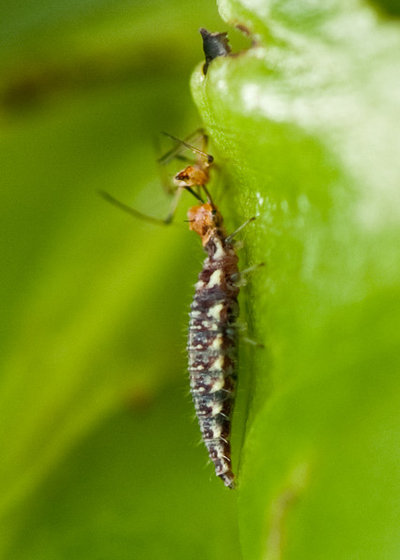
Holm Design & Consulting LLC
How to Spot LacewingsAdults. Green lacewing adults are pale to dark green and have four delicate, veined wings and metallic yellow eyes. Brown lacewings are light tan to dark brown, are usually smaller than green lacewings and are often nocturnal, meaning they fly at night.
Larvae. Lacewing babies are long, slender and often referred to as alligator-like, with a tapered head and tail. Green lacewing larvae have stripes and are spiky in appearance due to the hairs that protrude from their tubercles. Brown lacewing larvae are smooth in appearance and dark brown with cream or reddish-brown spots or stripes. Both green and brown lacewing larvae have prominent mouthparts (mandibles) that stick out in front of their head, which they use to capture their prey. Turn over a leaf on a plant afflicted by aphids, mealybugs or other prey insects to look for lacewing eggs or larvae.
Shown: A green lacewing larva feeding on an aphid
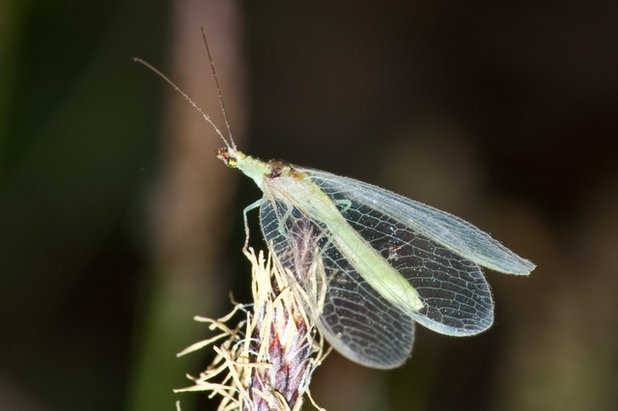
Holm Design & Consulting LLC
How to Lure ThemYou can attract lacewing adults by providing a diversity of plants, including flowering perennials, grasses and sedges. Ensure that flower food is available throughout the growing season, including early spring. To survive and thrive in the garden, lacewing adults need this diversity of plants, because they feed on pollen, nectar and even aphid honeydew. Providing the right habitat for lacewing adults means they will remain in your garden laying eggs and ultimately help you win the war on aphids.
Adults also need an undisturbed place in which to overwinter, where plant debris and leaves have been left in place. Most important, a pesticide-free garden will help maintain and improve beneficial insect populations, which will, in turn, keep problem populations in balance.
Plants for larvae: Any plant that is afflicted by aphids, mealybugs, thrips, whiteflies or psyllids.
Prey for larvae. Lacewing larvae are predaceous and feed on small insects, including aphids, leafhoppers, mealybugs, psyllids, thrips, mites, whiteflies, small caterpillars and insect eggs. Some brown lacewing adults also prey on small insects.
Shown: Green lacewing adult

Holm Design & Consulting LLC
Life cycle. Lacewings undergo a complete metamorphosis, from egg through three larval stages to pupa and then adult. Female lacewings look for aphid populations on plants and lay several eggs on the underside of leaves near the aphids. The eggs are white to cream colored and have an elongated oval shape. Larvae hatch approximately four days after eggs are laid and immediately begin feeding on insect prey.
When ready to pupate, the larvae spin silken, spherical cocoons attached to the underside of leaves, plant stems or debris, such as leaf litter on the ground or behind a piece of tree bark.
Many lacewings overwinter in cocoons. Cocoons attached to deciduous plant leaves eventually drop to the ground after a hard frost in late fall. The cocoon remains insulated in the leaf litter throughout the winter.
Lacewings that overwinter as adults look for a protected place, such as behind the bark on a tree or under leaf litter. Adults emerge in spring and seek out flowers, where they feed on pollen and nectar. Some brown lacewing adults are predaceous, like the larvae, and feed on small insects.
Region by region: What to Do in Your Garden This Month





